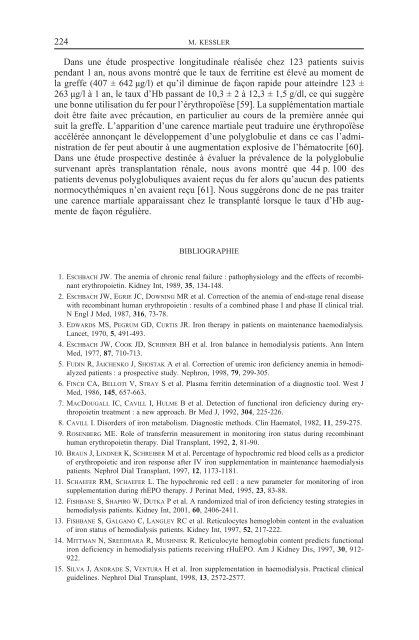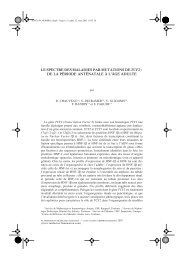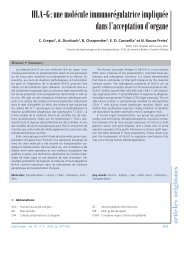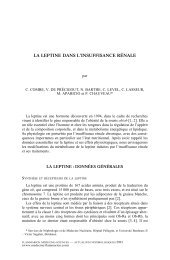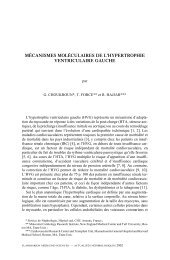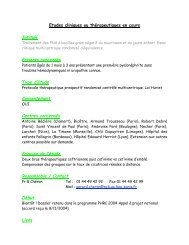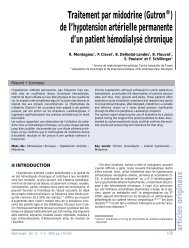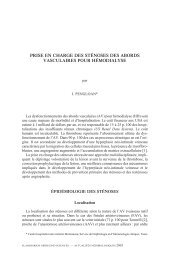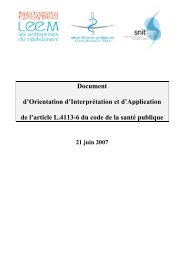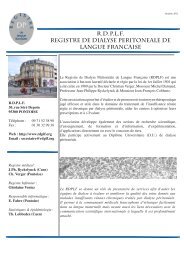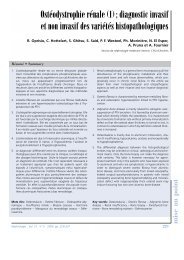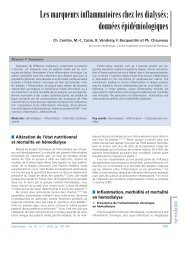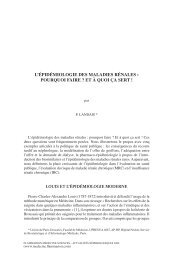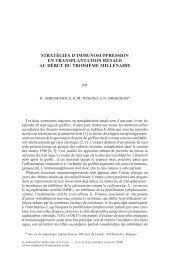224 M. KESSLERDans une étude prospective longitudinale réalisée chez 123 <strong>pati<strong>en</strong>t</strong>s suivisp<strong>en</strong>dant 1 an, nous avons montré que le taux de ferritine est élevé au mom<strong>en</strong>t dela greffe (407 ± 642 µg/l) et qu’il diminue de façon rapide pour atteindre 123 ±263 µg/l à 1 an, le taux d’Hb passant de 10,3 ± 2 à 12,3 ± 1,5 g/dl, ce qui suggèreune bonne utilisation <strong>du</strong> fer pour l’érythropoïèse [59]. La supplém<strong>en</strong>tation <strong>martial</strong>edoit être faite avec précaution, <strong>en</strong> particulier au cours de la première année quisuit la greffe. L’apparition d’une car<strong>en</strong>ce <strong>martial</strong>e peut tra<strong>du</strong>ire une érythropoïèseaccélérée annonçant le développem<strong>en</strong>t d’une polyglobulie et dans ce cas l’administrationde fer peut aboutir à une augm<strong>en</strong>tation explosive de l’hématocrite [60].Dans une étude prospective destinée à évaluer la préval<strong>en</strong>ce de la polyglobuliesurv<strong>en</strong>ant après transplantation <strong>rénale</strong>, nous avons montré que 44 p. 100 des<strong>pati<strong>en</strong>t</strong>s dev<strong>en</strong>us polyglobuliques avai<strong>en</strong>t reçus <strong>du</strong> fer alors qu’aucun des <strong>pati<strong>en</strong>t</strong>snormocythémiques n’<strong>en</strong> avai<strong>en</strong>t reçu [61]. Nous suggérons donc de ne pas traiterune car<strong>en</strong>ce <strong>martial</strong>e apparaissant chez le transplanté lorsque le taux d’Hb augm<strong>en</strong>tede façon régulière.BIBLIOGRAPHIE1. ESCHBACH JW. The anemia of chronic r<strong>en</strong>al failure : pathophysiology and the effects of recombinanterythropoietin. Kidney Int, 1989, 35, 134-148.2. ESCHBACH JW, EGRIE JC, DOWNING MR et al. Correction of the anemia of <strong>en</strong>d-stage r<strong>en</strong>al diseasewith recombinant human erythropoietin : results of a combined phase I and phase II clinical trial.N Engl J Med, 1987, 316, 73-78.3. EDWARDS MS, PEGRUM GD, CURTIS JR. Iron therapy in <strong>pati<strong>en</strong>t</strong>s on maint<strong>en</strong>ance haemodialysis.Lancet, 1970, 5, 491-493.4. ESCHBACH JW, COOK JD, SCRIBNER BH et al. Iron balance in hemodialysis <strong>pati<strong>en</strong>t</strong>s. Ann InternMed, 1977, 87, 710-713.5. FUDIN R, JAICHENKO J, SHOSTAK A et al. Correction of uremic iron defici<strong>en</strong>cy anemia in hemodialyzed<strong>pati<strong>en</strong>t</strong>s : a prospective study. Nephron, 1998, 79, 299-305.6. FINCH CA, BELLOTI V, STRAY S et al. Plasma ferritin determination of a diagnostic tool. West JMed, 1986, 145, 657-663.7. MACDOUGALL IC, CAVILL I, HULME B et al. Detection of functional iron defici<strong>en</strong>cy <strong>du</strong>ring erythropoietintreatm<strong>en</strong>t : a new approach. Br Med J, 1992, 304, 225-226.8. CAVILL I. Disorders of iron metabolism. Diagnostic methods. Clin Haematol, 1982, 11, 259-275.9. ROSENBERG ME. Role of transferrin measurem<strong>en</strong>t in monitoring iron status <strong>du</strong>ring recombinanthuman erythropoietin therapy. Dial Transplant, 1992, 2, 81-90.10. BRAUN J, LINDNER K, SCHREIBER M et al. Perc<strong>en</strong>tage of hypochromic red blood cells as a predictorof erythropoietic and iron response after IV iron supplem<strong>en</strong>tation in maint<strong>en</strong>ance haemodialysis<strong>pati<strong>en</strong>t</strong>s. Nephrol Dial Transplant, 1997, 12, 1173-1181.11. SCHAEFER RM, SCHAEFER L. The hypochronic red cell : a new parameter for monitoring of ironsupplem<strong>en</strong>tation <strong>du</strong>ring rhEPO therapy. J Perinat Med, 1995, 23, 83-88.12. FISHBANE S, SHAPIRO W, DUTKA P et al. A randomized trial of iron defici<strong>en</strong>cy testing strategies inhemodialysis <strong>pati<strong>en</strong>t</strong>s. Kidney Int, 2001, 60, 2406-2411.13. FISHBANE S, GALGANO C, LANGLEY RC et al. Reticulocytes hemoglobin cont<strong>en</strong>t in the evaluationof iron status of hemodialysis <strong>pati<strong>en</strong>t</strong>s. Kidney Int, 1997, 52, 217-222.14. MITTMAN N, SREEDHARA R, MUSHNISK R. Reticulocyte hemoglobin cont<strong>en</strong>t predicts functionaliron defici<strong>en</strong>cy in hemodialysis <strong>pati<strong>en</strong>t</strong>s receiving rHuEPO. Am J Kidney Dis, 1997, 30, 912-922.15. SILVA J, ANDRADE S, VENTURA H et al. Iron supplem<strong>en</strong>tation in haemodialysis. Practical clinicalguidelines. Nephrol Dial Transplant, 1998, 13, 2572-2577.
TRAITEMENT MARTIAL DU PATIENT EN INSUFFISANCE RÉNALE 22516. FISHBANE S, KOWALSKI EA, IMBRIANO LJ et al. The evaluation of iron status in hemodialysis<strong>pati<strong>en</strong>t</strong>s. J Am Soc Nephrol, 1996, 7, 2654-2657.17. KAUFMAN JS, REDA JD, FYE CL et al. Diagnostic value of iron indices in hemodialysis <strong>pati<strong>en</strong>t</strong>sreceiving epoetin. Kidney Int, 2001, 60, 300-308.18. KALENTAR-ZADEH K, HOFFKEN B, WUNSCH H et al. Diagnosis of iron defici<strong>en</strong>cy anemia in r<strong>en</strong>alfailure <strong>pati<strong>en</strong>t</strong>s <strong>du</strong>ring the post-erythropoietin era. Am J Kidney Dis, 1995, 26, 292-299.19. TESSITORE N, SOLERO GP, LIPPI G et al. The role of iron status markers in predicting response tointrav<strong>en</strong>ous iron in haemodialysis <strong>pati<strong>en</strong>t</strong>s on maint<strong>en</strong>ance erythropoietin. Nephrol Dial Transplant,2001, 16, 1416-1423.20. NKF-DOQI clinical practice guidelines for the treatm<strong>en</strong>t of anemia of chronic r<strong>en</strong>al failure. Nationalkidney foundation – dialysis outcomes quality intiative. Am J Kidney Dis, 1997, 4, S202-S212.21. European best practice guidelines for the managem<strong>en</strong>t of anaemia in <strong>pati<strong>en</strong>t</strong>s with chronic r<strong>en</strong>alfailure. Guideline 8 : Administration of supplem<strong>en</strong>tal iron. Nephrol Dial Transplant, 1999, 14, S17-S18.22. BESARAB A, AMIN N, AHSAN M et al. Optimization of epoetin therapy with intrav<strong>en</strong>ous iron therapyin hemodialysis <strong>pati<strong>en</strong>t</strong>s. J Am Soc Nephrol, 2000, 11, 530-538.23. KOOISTRA MP, NIEMANSVERDRIET EC, VAN ES A et al. Iron absorption in erythropoietin-treatedhaemodialysis <strong>pati<strong>en</strong>t</strong>s : Effects of iron availability, inflammation and aluminum. Nephrol DialTransplant, 1998, 13, 82-88.24. WINGARD RL, PARKER RA, ISMAIL N et al. Efficacy of oral iron therapy in <strong>pati<strong>en</strong>t</strong>s receiving recombinanthuman erythropoietin. Am J Kidney Dis, 1995, 25, 433-439.25. DOMRONGKITCHAIPORN S, JIRAKRANONT B, ATAMASTIKUL K et al. Indices of iron status in continuousambulatory peritoneal dialysis <strong>pati<strong>en</strong>t</strong>s. Am J Kidney Dis, 1999, 34, 29-35.26. SHAVER MJ, GOLPER TA. Clinical applications of iron managem<strong>en</strong>t in peritoneal dialysis <strong>pati<strong>en</strong>t</strong>s.Seminars in Dialysis, 1999, 12, 257-261.27. MACDOUGALL IC, TUCKER B, THOMPSON J et al. A randomized controlled study of iron supplem<strong>en</strong>tationin <strong>pati<strong>en</strong>t</strong>s treated with erythropoietin. Kidney Int, 1996, 50, 1694-1699.28. AHSAN N. Intrav<strong>en</strong>ous infusion of total dose iron is superior to oral iron in treatm<strong>en</strong>t of anemia inperitoneal dialysis <strong>pati<strong>en</strong>t</strong>s : a single c<strong>en</strong>ter comparative study. J Am Soc Nephrol, 1998, 9, 664-668.29. YEE J, BESARAB A. Iron sucrose : the oldest iron therapy becomes new. Am J Kidney Dis, 2002,40, 1111-1121.30. KOSCH M, BAHNER U, BETTGER H et al. A randomized, controlled parallel-group trial on efficacyand safety of iron sucrose (V<strong>en</strong>ofer) vs iron gluconate (Ferrlecit) in haemodialysis <strong>pati<strong>en</strong>t</strong>s treatedwith rHuEpo. Nephrol Dial Transplant, 2001, 16, 1239-1244.31. MACDOUGALL IC, CHANDLER G, ELSTON O et al. B<strong>en</strong>eficial effects of adopting an aggressive intrav<strong>en</strong>ousiron policy in a hemodialysis unit. Am J Kidney Dis, 1999, 34, S40-S46.32. CHANDLER G, HARCHOWAL J, MACDOUGALL IC. Intrav<strong>en</strong>ous iron sucrose : establishing a safe dose.Am J Kidney Dis, 2001, 38, 988-991.33. BESARAB A, KAISER JW, FRINAK S. A study of par<strong>en</strong>teral iron regim<strong>en</strong>s in hemodialysis <strong>pati<strong>en</strong>t</strong>s.Am J Kidney Dis, 1999, 34, 21-28.34. MACDOUGALL I, BAILIE G, RICHARDSON D et al. Worldwide safety profile of iron sucrose injection(V<strong>en</strong>ofer ®) ) : Analysis of 1 004 477 <strong>pati<strong>en</strong>t</strong>s from 1992 to 2001. J Am Soc Nephrol, 2002, 12, 333A.35. LUNDE N, PENNEL P, CHARYTAN C, et al. Safety of iron sucrose in the g<strong>en</strong>eral hemodialysis population.J Am Soc Nephrol, 2001, 12, 359A-360A.36. NYVAD O, DANIELSEN H, MADSEN S. Intrav<strong>en</strong>ous iron-sucrose complex to re<strong>du</strong>ce epoetin demandin dialysis <strong>pati<strong>en</strong>t</strong>s. Lancet, 1994, 344, 1305-1306.37. ZAGER RA, JOHNSON AC, HANSON SY, et al. Par<strong>en</strong>teral iron formulations : a comparative toxicologicanalysis and mechanisms of cell injury. Am J Kidney Dis, 2002, 40, 90-103.38. GEISSER P, BAER M, SCHAUB E. Structure/histoxicity relationship of par<strong>en</strong>teral iron preparation.Arzneimittelforschung, 1992, 42, 1439-1452.39. LIM PS, WEI YH, YU YL, et al. Enhanced oxidative stress in haemodialysis <strong>pati<strong>en</strong>t</strong>s receivingintrav<strong>en</strong>ous iron therapy. Nephrol Dial Transplant, 1999, 14, 2680-2687.40. CORTI MC, GAZIANO M, HENNEKENS CH. Iron status and risk of cardiovascular disease. AnnEpidemiol, 1997, 7, 62-68.


